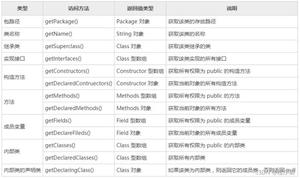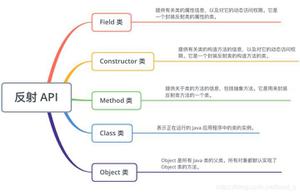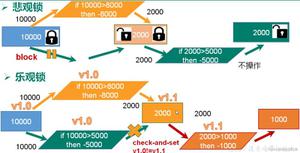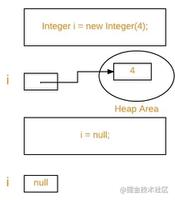基于Java回顾之反射的使用分析
反射可以帮助我们查看指定类型中的信息、创建类型的实例,调用类型的方法。我们平时使用框架,例如Spring、EJB、Hibernate等都大量的使用了反射技术。反射简单示例 下面来演示反射相关的基本操作
首先是基础代码,我们定义一个接口及其实现,作为我们反射操作的目标:
代码如下:
interface HelloWorldService { void sayHello(String name); } class MyHelloWorld implements HelloWorldService { public String name; public void sayHello(String name) { System.out.println("Hello " + name + "."); } public void setName(String name) { this.name = name; } public String getName() { return name; } }
获取方法及字段信息 下面的代码会输出给定类型中的方法和字段的声明信息: 代码如下:
private static void printClassTypeInfo(String type) throws ClassNotFoundException { Class classType = Class.forName(type); Method[] methods = classType.getDeclaredMethods(); System.out.println("Methods info as below:"); for(Method method : methods) { System.out.println(method.toGenericString()); } Field[] fields = classType.getFields(); System.out.println("Fields info as below:"); for (Field field : fields) { System.out.println(field.toGenericString()); } }
在使用反射时,我们一般会使用java.lang.reflect包中的内容。 然后我们调用下面的代码:
代码如下:
printClassTypeInfo("sample.reflection.MyHelloWorld");
输出结果如下: 代码如下:
Methods info as below:public void sample.reflection.MyHelloWorld.sayHello(java.lang.String)public java.lang.String sample.reflection.MyHelloWorld.getName()public void sample.reflection.MyHelloWorld.setName(java.lang.String)Fields info as below:public java.lang.String sample.reflection.MyHelloWorld.name
实例化对象 我们可以使用class.netInstance的方式来创建一个对象,代码如下: 代码如下:
private static void createInstanceTest() throws ClassNotFoundException, InstantiationException, IllegalAccessException { Class classType = Class.forName("sample.reflection.MyHelloWorld"); MyHelloWorld hello = (MyHelloWorld)classType.newInstance(); hello.sayHello("Zhang San"); }
输出结果: 代码如下:
Hello Zhang San.
调用对象的方法 我们可以通过方法的名称以及参数类型构建一个Method实例,然后调用Method的invoke方法,来触发方法。 示例代码如下:
代码如下:
private static void invokeMethodTest() throws InstantiationException, IllegalAccessException, ClassNotFoundException, NoSuchMethodException, SecurityException, IllegalArgumentException, InvocationTargetException { Class classType = Class.forName("sample.reflection.MyHelloWorld"); MyHelloWorld hello = (MyHelloWorld)classType.newInstance(); Method method = classType.getMethod("sayHello", new Class[]{String.class}); method.invoke(hello, new Object[]{"Zhang San"}); }
输出结果同上。 修改字段的值 和C#不同,Java中一般使用setxxx和getxxx显示为属性赋值,因此Java中并没有Property类型,而是有Field类型。
我们可以对Field的值进行修改,代码如下:
代码如下:
private static void setFieldTest() throws ClassNotFoundException, NoSuchFieldException, SecurityException, InstantiationException, IllegalAccessException { Class classType = Class.forName("sample.reflection.MyHelloWorld"); MyHelloWorld hello = (MyHelloWorld)classType.newInstance(); System.out.println("name is " + hello.name); Field field = classType.getField("name"); field.set(hello, "Zhang San"); System.out.println("name is " + hello.name); }
执行结果如下: 代码如下:
name is nullname is Zhang San
可以看出,我们成功的修改了name的值。 Annotation探索 一开始我们提到,反射是很多技术的基础,Annotation就是这样的,我们可以把Annotation看做是C#中的Attribute,它可以对类型、方法、属性、字段、方法参数等信息进行修饰。我们可以使用“@+Annotation名”的方式来使用Annotation。
Annotation基本操作 来看下面的代码,我们定义了基于Type、Method、Parameter和Field上面的Annotation示例:
代码如下:
@Target(ElementType.TYPE) @Retention(RetentionPolicy.RUNTIME) @Documented @interface ClassAnnotation { public String value(); } @Target(ElementType.METHOD) @Retention(RetentionPolicy.RUNTIME) @Documented @interface MethodAnnotation { public String methodName(); public String returnType(); } @Target(ElementType.PARAMETER) @Retention(RetentionPolicy.RUNTIME) @Documented @interface ParameterAnnotation { public String value(); } @Target(ElementType.FIELD) @Retention(RetentionPolicy.RUNTIME) @Documented @interface FieldAnnotation { public String value(); }
接着,我们定义了一个MyClass类型,使用了上述的Annotation: 代码如下:
@ClassAnnotation("这是作用在类型上的Annotation") class MyClass { @MethodAnnotation(methodName="printInfo", returnType="void") public void printInfo(String info) { System.out.println(info); } @MethodAnnotation(methodName="printError", returnType="void") public void printError(@ParameterAnnotation("这是作用在参数上的Annotation")String error) { System.err.println(error); } @FieldAnnotation("这是作用在字段上的Annotation") public int count; }
对于使用了Annotation,我们可以获取其中的信息,下面两种方式都可以获取Annotation,第一种方式是通过反射遍历类型及其方法、字段,一一读取Annotation信息;第二种方式是读取指定类型的Annotation: 代码如下:
读取Annotation方式一 private static void annotationTest1() { MyClass temp = new MyClass(); Annotation[] annotations = temp.getClass().getAnnotations(); for(Annotation a : annotations) { System.out.println(a.toString()); } Method[] methods = temp.getClass().getDeclaredMethods(); for(Method method : methods) { annotations = method.getAnnotations(); for(Annotation a : annotations) { System.out.println(a.toString()); } Annotation[][] paraAnnotations = method.getParameterAnnotations(); for(int i = 0; i < paraAnnotations.length; i++) { for (Annotation a : paraAnnotations[i]) { System.out.println(a.toString()); } } } Field[] fields = temp.getClass().getFields(); for (Field field : fields) { annotations = field.getAnnotations(); for(Annotation a : annotations) { System.out.println(a.toString()); } } }
代码如下:
读取Annotation方式二 private static void annotationTest2() throws ClassNotFoundException { Class classType = Class.forName("sample.reflection.annotation.MyClass"); boolean flag = classType.isAnnotationPresent(ClassAnnotation.class); if (flag) { ClassAnnotation annotation = (ClassAnnotation) classType.getAnnotation(ClassAnnotation.class); System.out.println(annotation.toString()); } Method[] methods = classType.getMethods(); for(Method method : methods) { if (method.isAnnotationPresent(MethodAnnotation.class)) { System.out.println(((MethodAnnotation)method.getAnnotation(MethodAnnotation.class)).toString()); } Annotation[][] paraAnnotations = method.getParameterAnnotations(); for(int i = 0; i < paraAnnotations.length; i++) { for (Annotation a : paraAnnotations[i]) { System.out.println(a.toString()); } } } Field[] fields = classType.getFields(); for (Field field:fields) { if (field.isAnnotationPresent(FieldAnnotation.class)) { System.out.println(((FieldAnnotation)field.getAnnotation(FieldAnnotation.class)).toString()); } } }
上述两个方法的输出都是一样的,如下: 代码如下:
@sample.reflection.annotation.ClassAnnotation(value=这是作用在类型上的Annotation)@sample.reflection.annotation.MethodAnnotation(methodName=printInfo, returnType=void)@sample.reflection.annotation.MethodAnnotation(methodName=printError, returnType=void)@sample.reflection.annotation.ParameterAnnotation(value=这是作用在参数上的Annotation)@sample.reflection.annotation.FieldAnnotation(value=这是作用在字段上的Annotation)
在WebService中使用Annotation 上述代码看上去可能有些枯燥,不能显示出Annotation的威力,那么我们接下来看WebService,在WebService中,我们可以使用WebMethod、WebParam等Annotation来声明方法或者参数。 接下来,我们来实现一个非常简单的Web服务:
代码如下:
@WebService(targetNamespace="http://test", serviceName="HelloService") public class HelloServiceProvider { @WebResult(name="HelloString") @WebMethod public String sayHello(@WebParam(name="userName") String name) { return "Hello " + name; } @Oneway @WebMethod(action="userLogin", operationName="userLogin") public void login() { System.out.println("User has logged on."); } public static void main(String[] args) { Thread thread = new Thread(new HelloServicePublisher()); thread.start(); } }
然后定义一个Publisher: 代码如下:
class HelloServicePublisher implements Runnable { public void run() { Endpoint.publish("http://localhost:8888/test/HelloService", new HelloServiceProvider()); } }
在命令行中,我们定位到源代码路径,执行下面的命令: 代码如下:
wsgen -cp . HelloServiceProvider
wsgen位于JDK的bin目录中。 然后我们启动HelloServiceProvider,在浏览器中输入如下地址:http://localhost:8888/test/HelloService,可以看到如下信息:
<!-- Published by JAX-WS RI at http://jax-ws.dev.java.net. RI's version is JAX-WS RI 2.2.4-b01. --><!-- Generated by JAX-WS RI at http://jax-ws.dev.java.net. RI's version is JAX-WS RI 2.2.4-b01. --><definitions targetNamespace="http://test" name="HelloService"><types><xsd:schema><xsd:import namespace="http://test" schemaLocation="http://localhost:8888/test/HelloService?xsd=1"/></xsd:schema></types><message name="sayHello"><part name="parameters" element="tns:sayHello"/></message><message name="sayHelloResponse"><part name="parameters" element="tns:sayHelloResponse"/></message><message name="userLogin"><part name="parameters" element="tns:userLogin"/></message><portType name="HelloServiceProvider"><operation name="sayHello"><input wsam:Action="http://test/HelloServiceProvider/sayHelloRequest" message="tns:sayHello"/><output wsam:Action="http://test/HelloServiceProvider/sayHelloResponse" message="tns:sayHelloResponse"/></operation><operation name="userLogin"><input wsam:Action="userLogin" message="tns:userLogin"/></operation></portType><binding name="HelloServiceProviderPortBinding" type="tns:HelloServiceProvider"><soap:binding transport="http://schemas.xmlsoap.org/soap/http" style="document"/><operation name="sayHello"><soap:operation soapAction=""/><input><soap:body use="literal"/></input><output><soap:body use="literal"/></output></operation><operation name="userLogin"><soap:operation soapAction="userLogin"/><input><soap:body use="literal"/></input></operation></binding><service name="HelloService"><port name="HelloServiceProviderPort" binding="tns:HelloServiceProviderPortBinding"><soap:address location="http://localhost:8888/test/HelloService"/></port></service></definitions> JDK中自带了Web服务器,我们不需要把上述代码部署到其他服务器中。
动态代理机制 Spring中一大特色是AOP,面向方面编程也是框架设计一个趋势。对于业务中的共通操作,诸如记录日志、维护事务等,如果和业务逻辑纠缠在一起,会造成代码职责不清,后续维护困难等问题。利用AOP,我们可以很好的分离共通操作和业务操作。
下面我们来实现一个简单的AOP框架,要实现这样一个框架,需要3部分:1)InvocationHandler,来触发方法;2)Interceptor,来定义拦截器;3)DynamicProxy,来动态创建代理对象。
首先我们看Interptor的定义:
代码如下:
interface AOPInterceptor { public void before(Method method, Object[] args); public void after(Method method, Object[] args); public void afterThrowing(Method method, Object[] args); public void afterFinally(Method method, Object[] args); }
接下来是InvocationHandler: 代码如下:
class DynamicProxyInvocationHandler implements InvocationHandler { private Object target; private AOPInterceptor interceptor; public DynamicProxyInvocationHandler(Object target, AOPInterceptor interceptor) { this.target = target; this.interceptor = interceptor; } public Object invoke(Object proxy, Method method, Object[] args) throws Throwable { try { interceptor.before(method, args); Object returnValue = method.invoke(target, args); interceptor.after(method, args); return returnValue; } catch(Throwable t) { interceptor.afterThrowing(method, args); throw t; } finally { interceptor.afterFinally(method, args); } } }
最后是DynamicProxy: 代码如下:
class DynamicProxyFactoryImpl implements DynamicProxyFactory { public <T> T createProxy(Class<T> clazz, T target, AOPInterceptor interceptor) { InvocationHandler handler = new DynamicProxyInvocationHandler(target, interceptor); return (T)Proxy.newProxyInstance(Thread.currentThread().getContextClassLoader(), new Class<?>[] {clazz}, handler); } }
至此,我们构建了一个”简易“的AOP拦截器。下面我们来创建一些测试代码。 首先是实现AOPInterceptor接口:
代码如下:
class MyInterceptor implements AOPInterceptor { public void after(Method method, Object[] args) { System.out.println("方法执行结束。"); } public void afterFinally(Method method, Object[] args) { System.out.println("方法体Finally执行结束。"); } public void afterThrowing(Method method, Object[] args) { System.out.println("方法抛出异常。"); } public void before(Method method, Object[] args) { System.out.println("方法开始执行"); } }
然后利用本文一开始定义的HelloWorldService,来完成测试,需要在MyHello的sayHello方法最后,追加一行代码: 代码如下:
throw new RuntimeException();
接着是测试代码: 代码如下:
private static void test() { MyInterceptor interceptor = new MyInterceptor(); HelloWorldService hello = new MyHelloWorld(); DynamicProxyFactory factory = new DynamicProxyFactoryImpl(); HelloWorldService proxy = factory.createProxy(HelloWorldService.class, hello, interceptor); proxy.sayHello("Zhang San"); }
最终,执行结果如下: 代码如下:
方法开始执行Hello Zhang San.方法抛出异常。方法体Finally执行结束。Exception in thread "main" java.lang.reflect.UndeclaredThrowableException at sample.reflection.dynamicproxy.$Proxy0.sayHello(Unknown Source) at sample.reflection.dynamicproxy.Sample.test(Sample.java:18) at sample.reflection.dynamicproxy.Sample.main(Sample.java:9)Caused by: java.lang.reflect.InvocationTargetException at sun.reflect.NativeMethodAccessorImpl.invoke0(Native Method) at sun.reflect.NativeMethodAccessorImpl.invoke(Unknown Source) at sun.reflect.DelegatingMethodAccessorImpl.invoke(Unknown Source) at java.lang.reflect.Method.invoke(Unknown Source) at sample.reflection.dynamicproxy.DynamicProxyInvocationHandler.invoke(Sample.java:60) ... 3 more
可以看出,我们已经在业务执行的前、后、异常抛出后以及finally执行后进行了拦截,达到了我们期望的效果。以上是 基于Java回顾之反射的使用分析 的全部内容,
来源链接:
utcz.com/p/207032.html










